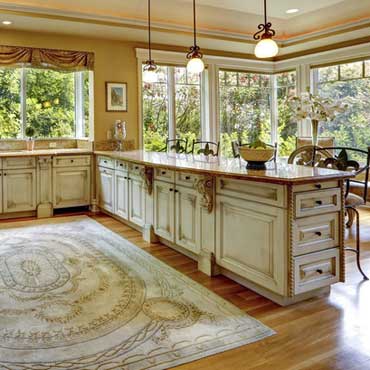
If you are looking for a magnificently patterned
wool carpet woven in the most stunning array of colors, you may want to consider an axminster rug. The "axminster" power look was invented in England in the mid 19th century. It was invented to simulate the beauty of hand
woven carpet. Axminster rugs are unique due to their intricate patterns and European style. Axminster rugs are found in five star
hotels , casinos and gorgeous homes throughout the world. Not only are they striking, an axminster rug is constructed to withstand the heaviest of traffic included hotel
lobbies, cruise ships, or perhaps your busy home. If you have a elegant staircase or a special room to carpet an
Axminster rug definitely makes a statement.
An Axminister rug machine weaves up to 70 colors of yarn onto a flexible cotton frame. Its invention in 1882 in the midst of the industrial revolution practically destroyed the hand-knotted rug industry. It was thought that mechanized items were all going to be of superior quality, a theory later proved wrong.
Like an oriental rug, fibers are woven in and out through the surface backing on an Axminster rug carpet machine. This loom inserts pile tufts into the weave from above so that strands need not run along the back, enabling a multitude of colors to be used. Chosen by hotels and commercial lobbies for its durability and cleanability, the surface is a cut pile, available in long and shaggy, short and smooth, stubby or carved carpets. Yard for yard, it is comparatively more expensive than carpets made on high speed modern tufting machines.
Disclaimer: The information provided in this article is for general informational purposes only. While we strive to ensure the accuracy and reliability of the information presented, we make no warranties, express or implied, about the completeness, accuracy, reliability, suitability, or availability with respect to the content. Any reliance you place on such information is strictly at your own risk. We recommend consulting with professionals for specific advice tailored to your project’s needs, particularly regarding building codes, regulations, and product specifications.
Under no circumstances shall we be liable for any loss or damage, including without limitation, indirect or consequential loss or damage, arising from the use of, or reliance on, the information provided in this article.

 If you are looking for a magnificently patterned
If you are looking for a magnificently patterned 
